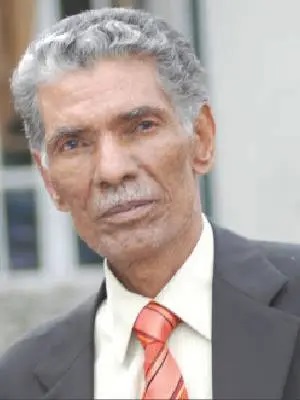
The late Mesfin Habte Mariam was perhaps the foremost Ethiopian author of satirical short stories. He is mostly remembered for his collection of short stories entitled, "Ye Buna Bet Se'elotch" or the Tavern Drawings, which is the main story in the collection from which the book took its title. Mesfin was not only a narrator of tales. He was also a writer of satirical tales that force you to laugh until your sides burst.
Mesfin was also a seasoned translator of American classical authors like Earnest Hemingway (The Old man and the Sea) and O. Henry's short stories. He was also a serious translator of the tales of Russian classical author Anton Chekhov. Mesfin was also translated plays and short works of fiction from the authors he liked most.
He was also well versed in Latin American Literature and magical realism long before Gabriel Garcia Marquez was known among the Ethiopian literati.
Drawings on the walls of taverns are popular artistic expressions of older amateur painters who earned their livings by doing portraits of individuals in their neighborhoods as well as at work. I remember a resident of my old neighborhood who commissioned an amateur artist for painting his picture that served as his official portrait and was paraded during his burial when he died. Although the dead person and his portrait had a remote resemblance, those who attended the burial ceremony were all in tears when they looked at it. That was not as such because of the moving artistic quality of the portrait but because of the loss of a good man they knew in flesh a few days ago. In one of the tavern masterpieces for instance, a man is featured holding his rifle and aiming at an invisible target in the distance. What is shocking with this picture was the size of the rifle whose barrel touched the pick of the mountain on the other side of what appeared to be a small river. The sense of proportion of the unknown artist who painted that picture was awful to say the least, The man with the rifle rather looked like a poacher and his field of operation was located among the mountains. The other shocking thing in this picture is the absence of the target at which the rifle was aimed as there was no wild animal in the area.
Another portrait painted on the wall of one of the taverns I had the chance to visit, featured a man with a rifle hanging from one of his shoulders. He was sitting on a horse whose size defies human imagination. The man with the rifle sits on the back of a horse whose length could be almost equal to the size of a limousine sedan. It is defying the imagine because there is no horse that size in real life. The purpose of that painting may be to show or imagine a prosperous person, perhaps an aristocrat, who enjoys the sport of hunting wild animals in the old days.
Two main themes dominate Ethiopian traditional paintings as drawn on public places like the walls of drink joints or taverns, or on various canvasses. Portraits of heroes, beautiful landscapes and animals like horses, lions and rare species like the mountain Nyala, among others. These animals feature most often than not on paintings in taverns, maybe because they are symbolic. The first symbolizes courage while the latter represents rarity or preciousness, which is also one of the main features of the country itself. Ethiopia is home to rare fauna and flora and this is reflected in the imaginations of many popular artists.
As a nation of warriors, Ethiopia and its emperors are long known for adopting the lion as the symbol of the nation itself. Veteran historical novelist Berhane Sellassie
has written a book about emperor Theodros entitled, "Warrior King". His contemporary Berhanu Zerihun has penned his famous "Ye Teodros Enba"
(Theodros' Tears) that he later on re-wrote under another title, "Ye Tangut Mister" (Tangut's Secret). Our traditional artists were quick to produce their own versions of national heroes like emperor Theodros who legendary courage is sometimes associated with that of a lion.
Speaking of the lion as a symbol of courage, I remember an old village artist who was doing a portrait on the wall of a tavern paintings featured many animals among which is a man standing with the head of a lion and the other physical features of a human being. I asked the artist why he gave the man in the picture the head of a lion. His answer was unequivocal. he told me that the man who commissioned the painting was the owner of the tavern and he wanted to be portrayed with the head of a lion. The lion has long dominated Ethiopian popular imagination as the symbol of greatness and courage.
In the imagination of most popular artists, emperor Theodros is seen as a handsome, fierce looking young man in dreads, wearing the traditional shemma, a hand-woven fabric he held together with a belt under which features a pistol, the same pistol that took his life in the last hour of his defeat in the hands of British expeditionary forces led by Napier. Back in the 1960s and 1970s, the emperor's dreadlocks were the rage of the Addis Ababa youth who saw in his hairstyle a symbol of heroism and defiance of foreign aggressors.
The "Teddy-style" dreads were the precursors of Rasta hair style which is also regarded as a symbol of love, revolution and defiance. By the way, many Ethiopian traditional painters have done the portraits of Bob Marley who is considered the father of the music style known as Reggae Beat. Those who do not trust my words can go and check at any hangout in Shashemene or right here in Addis whenever they visit stylish pubs frequented by young people.
Many popular artists have painted their portraits that are featured everywhere, fromtaverns to palaces. Musicians produced classical melodies eulogizing the courage and visions of the late emperor. Teodros Kassahun, alias Teddy Afro, has also produced what may go as the best music ever written in praise of the late emperor.
The lion was, and still is, another symbol that featured everywhere, on coins, seals, big palaces and army fatigues under the late emperor Haile Sellassie who claimed that his symbol was the Lon of Judah as he made allusion to his Jewish ancestry starting from the legendary King Solomon and Queen Sheba encounter that gave rise to the Solomonic dynasty. Whether this is true story or the figment of a fertile imagination is something that needs to be settled by historians specializing.
THE ETHIOPIAN HERALD OCTOBER 10/2021




